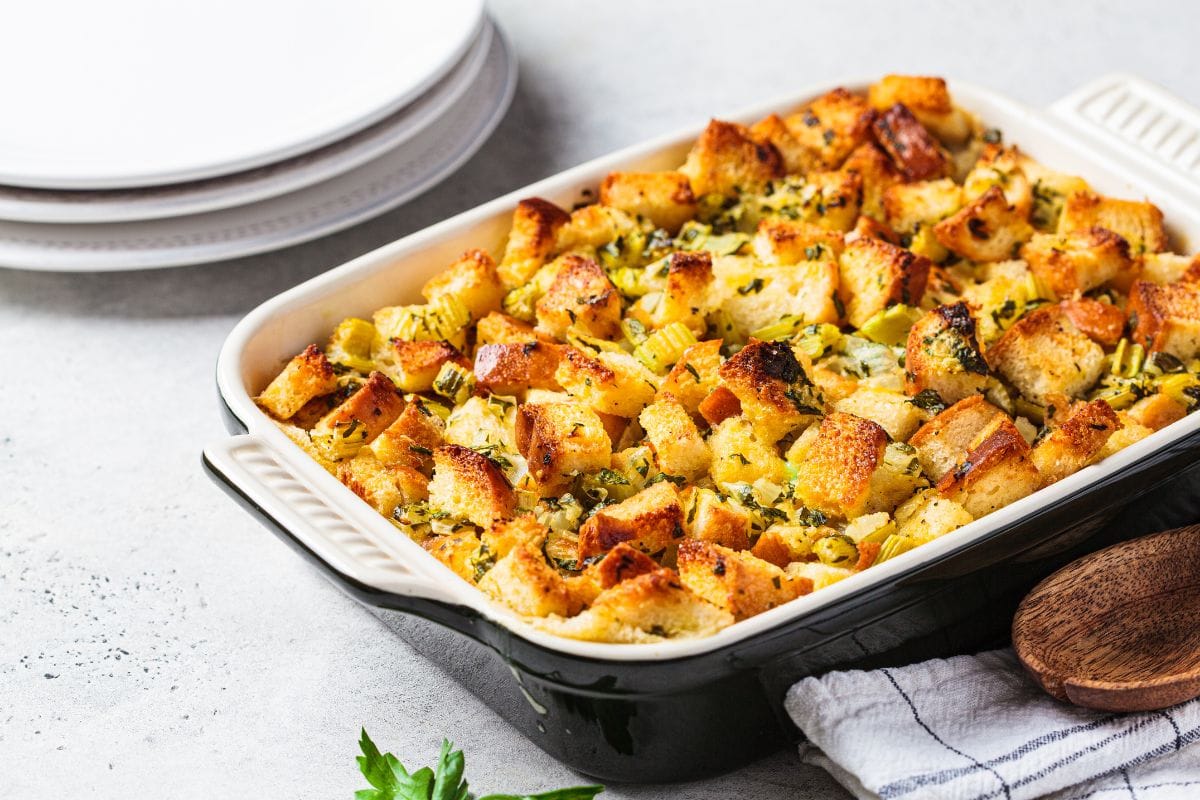What is Sourdough Bread Stuffing?
If you’ve never tried sourdough bread stuffing, you’re in for a treat. This delicious side dish takes the traditional stuffing recipe up a notch with the tangy, chewy goodness of sourdough bread. Popular during Thanksgiving, it’s a fantastic way to add a unique twist to your holiday table. The slightly sour flavor of the bread pairs beautifully with savory herbs, making every bite a burst of flavor.
Why Sourdough Bread Elevates Your Stuffing
Stuffing, or dressing as it’s sometimes called, is a staple on many holiday tables. Traditional recipes often use white or wheat bread, but sourdough bread stuffing offers a delightful change. The natural tanginess of sourdough complements the rich, savory flavors of the herbs and broth, creating a dish that’s both comforting and sophisticated. Imagine a forkful of stuffing, where each cube of bread has absorbed the fragrant broth, herbs, and seasonings, providing a perfect balance of textures and flavors.
Why Choose Sourdough for Stuffing?
Choosing sourdough for your stuffing isn’t just about taste—it’s also about texture and health benefits. Sourdough bread stuffing has a unique chewiness that holds up well when mixed with broth and baked, ensuring your stuffing isn’t a soggy mess. Plus, the natural fermentation process in sourdough breaks down some of the gluten and makes the nutrients more accessible, which can be easier on your digestive system.
Health Benefits of Sourdough Bread in Stuffing
The fermentation process involved in making sourdough bread not only imparts a distinctive flavor but also brings several health benefits. The longer fermentation period allows for the breakdown of phytates, which can inhibit the absorption of minerals. This means that the nutrients in sourdough bread are more bioavailable compared to other types of bread. Furthermore, the tangy taste of sourdough pairs exceptionally well with the savory ingredients typically found in stuffing, such as herbs, onions, and celery. For more on why sourdough makes such a great stuffing ingredient, check out this homemade sourdough stuffing recipe.
Ingredients and Preparation
Essential Ingredients for Sourdough Bread Stuffing
To make the best sourdough bread stuffing, you’ll need some key ingredients:
- Sourdough bread: the star of the dish
- Herbs: sage, thyme, and rosemary are classics
- Spices: salt and pepper to taste
- Vegetables: onions, celery, and sometimes even apples or mushrooms
- Broth: chicken or vegetable, depending on your preference
- Butter: for sautéing and adding richness
Each ingredient plays a crucial role in the overall flavor and texture of the stuffing. The sourdough bread stuffing provides a sturdy base that soaks up the savory broth without falling apart. Fresh herbs like sage, thyme, and rosemary add layers of earthy flavor, while onions and celery contribute a satisfying crunch and aromatic depth. Butter, of course, adds richness and helps to meld all the flavors together. You can tweak these ingredients to suit your taste, but these basics will ensure your stuffing is full of flavor. For an easy-to-follow recipe, visit The Pantry Mama.
Preparing the Sourdough Bread
Preparation starts the night before. Here’s how to get your bread ready:
- Cut the bread into 1-inch cubes.
- Spread the cubes on a baking sheet and leave them out overnight to dry.
- If you’re short on time, toast the cubes in the oven at a low temperature until they’re dried out.
Dry bread cubes absorb the broth better, ensuring your stuffing has the perfect texture. Drying out the bread cubes is essential because it prevents the stuffing from becoming too mushy. The dried bread cubes will soak up the broth and flavors without disintegrating, giving you a stuffing that’s moist but still holds its shape. If you prefer, you can speed up this process by toasting the bread cubes in the oven at a low temperature for about 30 minutes. This method is especially handy if you’re pressed for time or if you forgot to prep the bread the night before.
Cooking Instructions
How to Make Sourdough Bread Stuffing
Now, let’s get cooking. Follow these steps for a perfect stuffing:
- Preheat your oven to 350°F (175°C).
- In a large skillet, melt butter and sauté chopped onions, celery, and garlic until soft.
- In a large bowl, combine the bread cubes with the sautéed vegetables and fresh herbs.
- Whisk together broth and eggs in a separate bowl, then pour this mixture over the bread, tossing to coat evenly.
- Transfer everything to a greased baking dish, cover with foil, and bake for 30 minutes. Remove the foil and bake for another 15-20 minutes until the top is golden and crispy.
Cooking sourdough bread stuffing is straightforward, but a few key steps ensure the best results. First, be sure to sauté the vegetables until they’re tender but not browned, as this brings out their sweetness and ensures a soft texture. Mixing the broth and eggs before adding them to the bread cubes helps distribute the moisture evenly, ensuring every piece of bread is perfectly coated. When baking, covering the dish with foil traps steam, which helps cook the stuffing through without drying it out. Removing the foil for the last part of the baking process allows the top to get beautifully crispy.
Tips for Perfect Sourdough Stuffing
To ensure your stuffing turns out perfectly every time, keep these tips in mind:
- Avoid sogginess by not over-soaking the bread cubes. They should be moist, not drenched.
- Achieve a crispy top by removing the foil for the last part of the baking.
- Balance herbs and spices by tasting the mixture before baking and adjusting as needed.
If you’re worried about soggy stuffing, consider the moisture content of your bread cubes and the amount of broth you use. Start with less broth, adding more as needed to achieve the right consistency. For a crispy top, ensure the foil is removed for the final baking stage. This step is crucial for achieving that golden-brown crust that makes stuffing so delightful. Finally, always taste the mixture before baking. This allows you to adjust the seasoning, ensuring a well-balanced flavor.
Variations and Serving Suggestions
Variations of Sourdough Bread Stuffing
There are endless ways to customize your stuffing:
- Add sausage: Brown some sausage and mix it in for a heartier stuffing.
- Incorporate nuts or dried fruits: Pecans, cranberries, or apricots add a delightful twist.
- Make it vegetarian: Simply use vegetable broth instead of chicken.
For more creative ideas, take a look at this easy sourdough stuffing recipe. Adding sausage to your stuffing not only increases its richness but also adds a savory, meaty flavor that pairs wonderfully with sourdough bread and herbs. Nuts and dried fruits, on the other hand, provide a sweet and crunchy contrast that can make your stuffing stand out. If you have dietary restrictions, using vegetable broth ensures your stuffing is vegetarian-friendly without sacrificing flavor.
Serving Suggestions for Sourdough Bread Stuffing
This stuffing pairs perfectly with traditional Thanksgiving dishes:
- Roast turkey or chicken
- Mashed potatoes and gravy
- Cranberry sauce
For presentation, garnish with fresh herbs and serve in a beautiful casserole dish. Sourdough bread stuffing isn’t just for Thanksgiving, though. It can be a fantastic side dish for any special meal or holiday dinner. Serve it alongside roast chicken or pork chops for a comforting, hearty meal. For an elegant touch, garnish the stuffing with fresh herbs like parsley or sage before serving. This not only adds a pop of color but also enhances the aromatic appeal of the dish.
Storage and Reheating
How to Store Leftover Sourdough Bread Stuffing
Got leftovers? No problem. Store your stuffing properly to enjoy it later:
- Refrigerate: Keep in an airtight container for up to 4 days.
- Freeze: Store in a freezer-safe container for up to 2 months. Thaw in the fridge overnight before reheating.
Storing leftover sourdough bread stuffing properly ensures you can enjoy it days later without any loss of flavor or texture. In the refrigerator, make sure the container is airtight to prevent the stuffing from drying out. If freezing, divide the stuffing into smaller portions for easier reheating. When ready to eat, thaw the stuffing in the fridge overnight to ensure it heats evenly.
Reheating Sourdough Bread Stuffing
Reheating is easy and ensures your stuffing stays delicious:
- Oven: Preheat to 350°F (175°C), cover with foil, and bake until heated through, about 20 minutes.
- Microwave: For a quick option, microwave on high in 1-minute intervals until warm.
Add a splash of broth if it seems a bit dry after reheating. Reheating in the oven is the best method to maintain the stuffing’s texture and flavor. If you’re short on time, the microwave works, but be sure to check and stir frequently to prevent uneven heating. Adding a bit of broth or butter before reheating can help keep the stuffing moist and flavorful.
Nutritional Information and Benefits
Nutritional Benefits of Sourdough Bread Stuffing
Sourdough bread stuffing isn’t just tasty—it’s also nutritious. Here’s a closer look at the benefits:
- Rich in Fiber: The whole grains and natural fermentation process in sourdough bread increase its fiber content. Fiber aids in digestion, helps maintain healthy blood sugar levels, and can contribute to a feeling of fullness, which can help with weight management.
- High in Vitamins and Minerals: The vegetables and herbs used in stuffing, like onions, celery, sage, and thyme, are packed with vitamins A, C, and K, as well as minerals like potassium and magnesium. These nutrients are essential for maintaining a healthy immune system, promoting bone health, and supporting overall bodily functions.
- Lower in Gluten: Sourdough bread is easier to digest for some people because the fermentation process breaks down some of the gluten and phytic acid present in the flour. This can make sourdough a better option for those with mild gluten sensitivities.
- Probiotics and Prebiotics: The fermentation process in sourdough can lead to the development of beneficial bacteria, or probiotics, which are good for gut health. Additionally, the fiber in sourdough bread acts as a prebiotic, feeding the good bacteria in your gut and promoting a healthy digestive system.
- Antioxidants: The herbs used in stuffing, such as sage, thyme, and rosemary, are rich in antioxidants. These compounds help combat oxidative stress in the body, reducing inflammation and lowering the risk of chronic diseases.
- Healthy Fats: When you use ingredients like olive oil or butter in your stuffing, you’re adding healthy fats to your diet. These fats are crucial for absorbing fat-soluble vitamins, maintaining cell health, and providing a long-lasting source of energy.
Frequently Asked Questions About Bread Stuffing
What is the best bread to use for stuffing?
The best bread for stuffing is typically white bread due to its neutral flavor, tight crumb, and low hydration level. This allows it to absorb the stuffing’s flavors and moisture effectively. Other good options include challah and brioche, which also have a tight crumb and can absorb liquids well.
How do you dry sourdough for stuffing?
To dry sourdough for stuffing, cut it into cubes and spread them on a baking sheet. Place the sheet in a low oven (about 195°F or 90°C) for 60-90 minutes until the bread is completely dry but not toasted. Alternatively, you can leave the bread out on the countertop for a few days to let it become stale naturally.
What not to do with sourdough?
When using sourdough for stuffing, avoid using it when it’s too fresh or highly hydrated, as this can lead to soggy stuffing. Also, ensure the bread is fully dried out to absorb the liquids properly and prevent a mushy texture.
What pairs well with sourdough bread?
Sourdough bread pairs well with a variety of ingredients. For stuffing, consider pairing it with traditional flavors like sage, thyme, onions, celery, and chicken broth. Outside of stuffing, sourdough complements cheeses, charcuterie, and hearty soups due to its robust flavor and texture.







